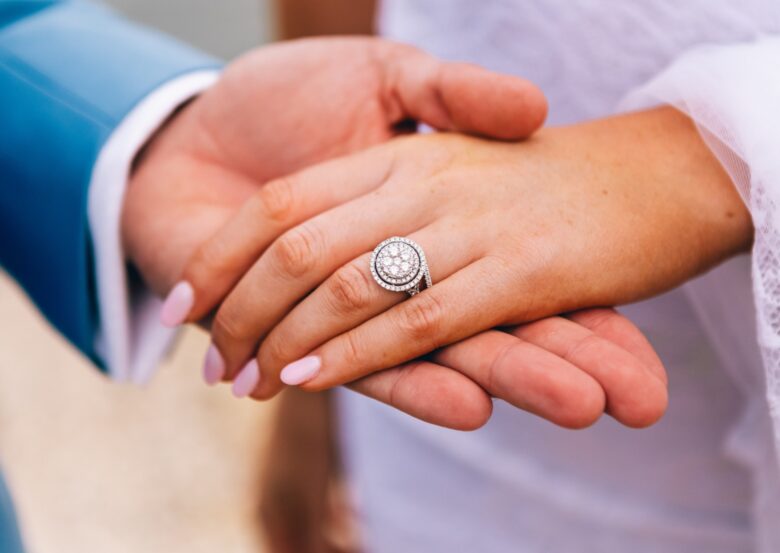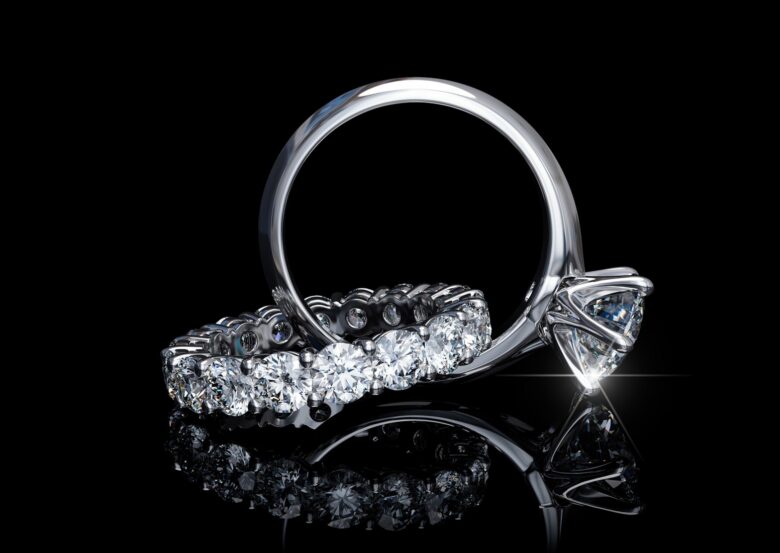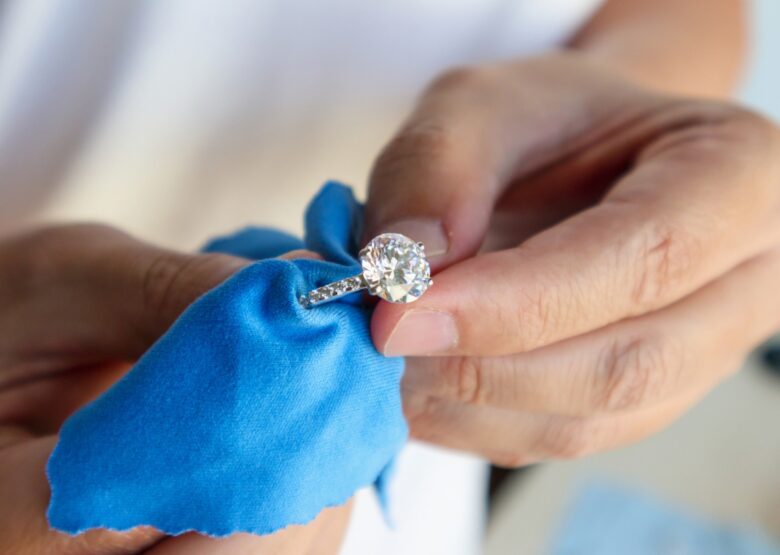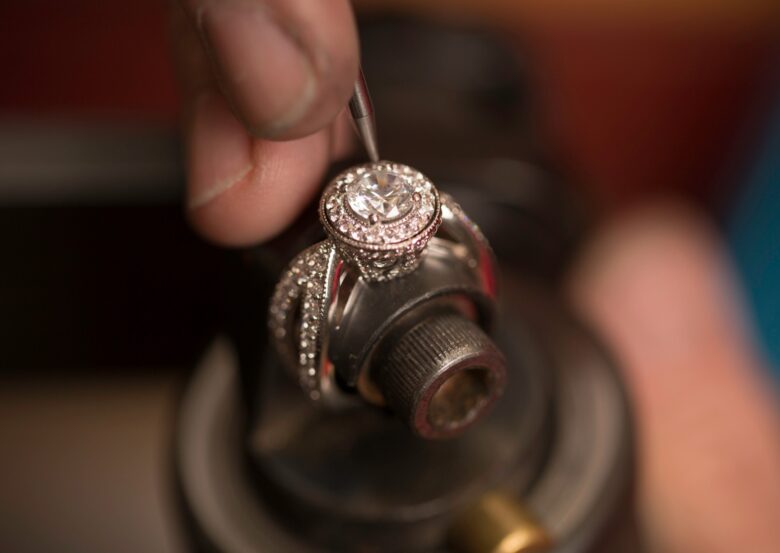In the world of fine jewelry, few pieces hold the allure and enchantment quite like pavé diamond rings. These exquisite creations marry the timeless elegance of diamonds with the intricate craftsmanship of delicate details, resulting in a dazzling statement piece that captures the hearts of wearers and onlookers alike. Jewelry includes all sorts of interesting details and unfamiliar terms – there’s a lot to learn about jewelry. One common jewelry detail is a pavé setting, and the term pavé means pavement in French.
If you see the term pavé in a ring’s description, it refers to the smaller diamonds set closely together on the setting. The small diamonds add additional sparkle and provide a unique look. Pavé diamonds are held in place with metal prongs or beads to look like a continuous area or line of small diamonds. Side diamonds or band diamonds are larger, while pavé diamonds are typically about 0.01 to 0.02 carats.

Source: canva.com
Contents
A Glittering Legacy
The roots of pavé diamond work can be traced back to the 17th century when skilled artisans in Europe began experimenting with various techniques to create intricate patterns and settings for precious stones. The pavé technique, as we know it today, gained prominence during the Art Deco era of the 1920s and 1930s, where it became synonymous with the era’s geometric designs and symmetrical patterns.
Renowned jewelry houses like Cartier and Van Cleef & Arpels incorporated pavé diamonds into their creations, solidifying the technique’s status as a hallmark of high-end craftsmanship.
The Allure of Contrasts
Combining bold and delicate details in jewelry design creates an interesting contrast. Imagine a setting with a large center stone and a sea of pavé small, closely-set diamonds to create drama and sparkle. Pavé is a versatile detail that goes well with plenty of ring designs. Browse rings online (or in person) to better understand the pavé possibilities.
Design Elements
Pavé diamonds require intricate, delicate care by the jeweler, especially if the band is thinner and the diamonds are extra small. Jewelers drill tiny holes into the band to set the pavé diamonds. Then the jeweler adds tiny metal beads or small prongs to secure the diamonds in place. You’ll also see even smaller pavé diamonds, but these are considered “micro-pavé” and are set in thin bands. These delicate details complement the boldness of a setting with densely packed diamonds.

Source: canva.com
Versatility in Style
The pave setting is also versatile enough to work well in many types of jewelry pieces, including engagement rings, wedding bands, cocktail rings, and stackable bands. Now that you know more about pavé settings, you’ll notice them in more jewelry pieces. You can stack different pavé rings for a bold statement or wear a single ring for a more minimalist look.
Celebrity Inspirations
Another place to look for pavé ideas is celebrities because many celebrity engagement rings feature delicate pave detailing. Some of our favorite engagement rings are Kourtney Kardashian, Chrissy Teigen, and Blake Lively. Kourtney and Travis Barker, the Blink-182 drummer, got engaged in late 2021. Her stunning ring features an oval-cut diamond engagement ring that’s about 15 carats. It has a delicate pavé band, so the larger, bold diamond contrasts the dainty band, which makes a balanced engagement ring. Another impressive engagement ring with pavé details is Chrissy Teigen’s engagement ring. It’s a cushion-cut diamond on a pavé eternity band.
Chrissy creates a bold look by pairing her engagement ring from singer John Legend with pavé diamond eternity bands on either side of her engagement ring. The lovely stack features a bold, large diamond with delicate pavé details. Actress Blake Lively’s engagement ring incorporates some unique details.
Blake Lively and actor Ryan Reynolds had a secret engagement. Ryan proposed with a 12-carat oval-cut diamond solitaire engagement ring with a micro pavé band. The rose gold setting pairs well with the pink diamond, and the bold-colored diamond contrasts with the tiny diamonds in the band.

Source: canva.com
Caring for Pavé Diamond Rings
Dirt and grime can hide in pave settings. Fill a bowl with warm water and add a few drops of mild dishwashing liquid. Let your ring soak for a few minutes – the dirtier the ring, the more minutes it needs to soak. Use a soft toothbrush and gently brush behind the stones where grime and dirt can collect. In addition to periodic cleanings, you’ll want to have your ring inspected yearly by a professional jeweler.
The jeweler can take a closer look at the pavé-set stones to make sure they’re securely held in place, and all the prongs are in good condition. Whether natural or lab-made diamonds, losing a stone alters the look of the ring and costs you money to replace and fix. Therefore a professional inspection will always be helpful.
Closing Thoughts
Pavé settings add a dainty detail to any ring, from engagement to wedding bands. Tiny pavé diamonds pair well with large diamonds to create a balanced ring with a bold look. An easy way to remember pavé is that it’s the French word for pavement, and a thicker setting with plenty of small diamonds looks like a sparkling street of stones.
It’s a versatile detail that goes well with a variety of designs, and you can always look to celebrities for ring inspiration. No matter what type of setting you choose, care for it carefully so it’ll last for years.

Source: canva.com
Conclusion
In the world of fine jewelry, pavé diamond rings stand as a testament to the harmony between boldness and delicacy. Their intricate craftsmanship and timeless beauty capture the essence of love, celebration, and personal expression, making them cherished symbols of life’s most significant moments.
As pavé diamond rings continue to inspire and captivate, they remind us that even the smallest details can make the boldest statements, weaving together a tapestry of brilliance that stands the test of time.
